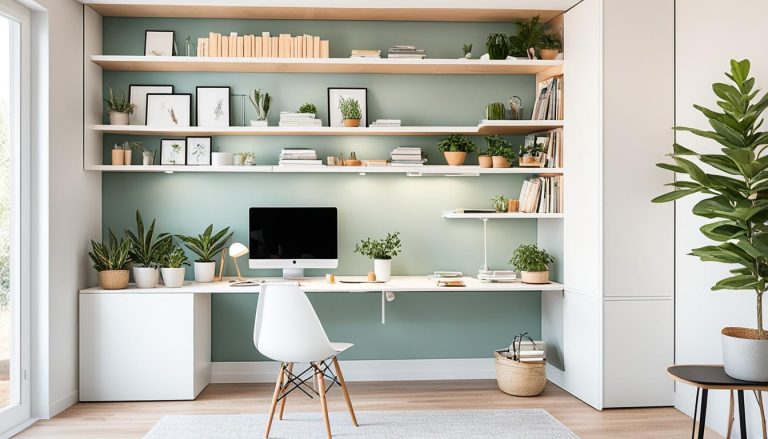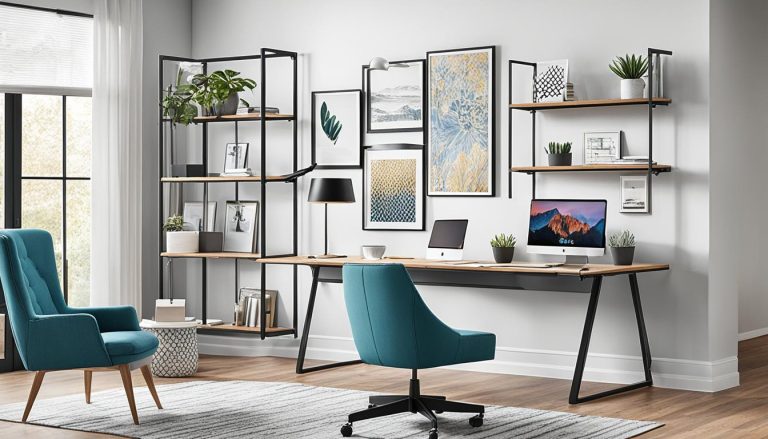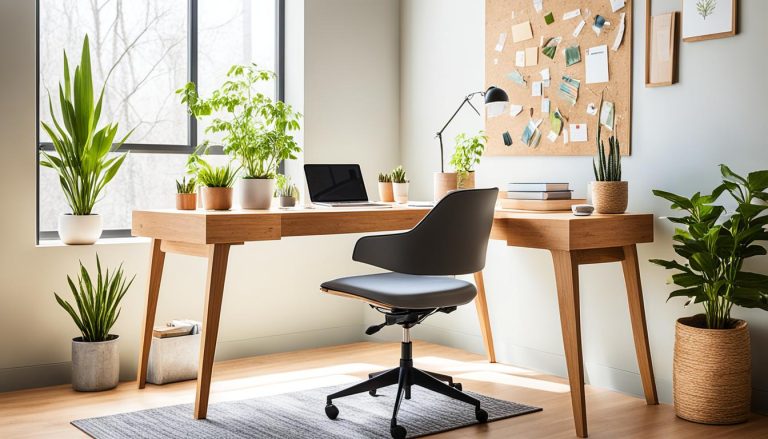Cozy Home Office Design for Couples: Shared Spaces
houseremodelingnews.com may earn a commission if you purchase a product through one of our links
“The secret of a happy marriage is finding the right person. You know they’re right if you love to be with them all the time.” – Julia Child
Remote work is becoming more common, leading couples to share not just a home but also workspaces. Now, 73% of home offices have areas for two people to work together. If you’re in a couple working from home, you’ll find this interesting.
Creating a cozy home office for couples is more than just fitting two desks in a room. It’s about making a space that boosts both partners’ productivity and respects their needs. We’ll look at smart storage and ergonomic tips to make your space both useful and welcoming.
Did you know 52% of home offices put desks against walls? This setup saves space and keeps the middle area open for moving around. We’ll share more tips to help you and your partner do well in your shared office.
Understanding the Need for Shared Workspaces
Remote work has led to a new trend: work from home couples. More partners are sharing their living and work areas. This makes having a well-designed couples home office setup very important.
The rise of remote work for couples
Remote work has changed how couples work together. Many couples now need to make their homes into collaborative home offices. This has caused a big increase in home office remodels and renovations in the U.S.
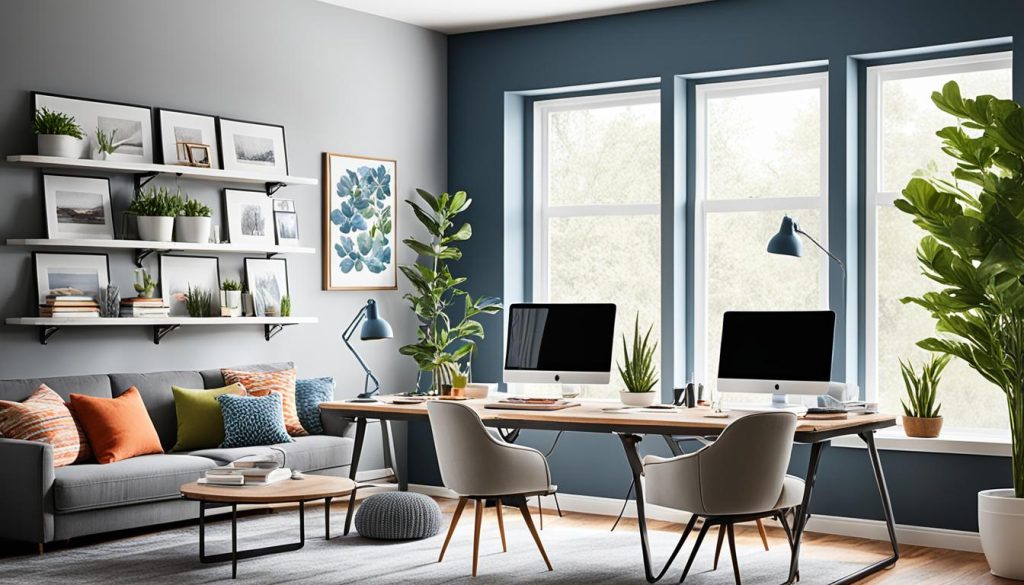
Challenges of working from home together
Working together from home has its own set of challenges. Couples often struggle with limited space, different work styles, and distractions. They also worry about privacy and keeping noise down in shared offices.
- Balancing individual needs and preferences
- Managing noise levels and distractions
- Creating distinct work zones in limited space
Benefits of a shared home office
Despite the challenges, a shared workspace has many benefits for work from home couples. A well-thought-out setup can improve collaboration, save space, and boost motivation.
A shared home office allows couples to enjoy each other’s company while maintaining productivity.
By understanding these points, couples can make a workspace that works well for both of them.
Assessing Your Available Space
Start by looking at your living area for spots to turn into work zones. Spare bedrooms, unused corners, or parts of your living room can work well as office nooks.
Think about these things when checking out spots for a home office:
- Natural light sources
- Wall space for shelving or artwork
- Proximity to shared areas for breaks
- Electrical outlets for equipment
Being flexible is crucial with limited space. L-shaped desks are great because they’re versatile and give lots of room for different tasks. They’re perfect for shared spaces, letting couples work together easily.
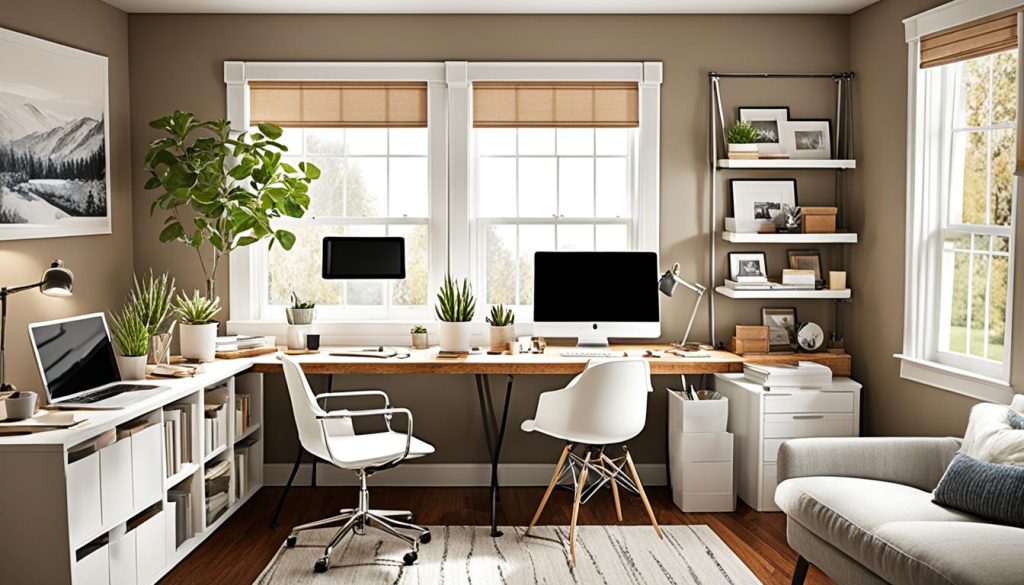
Don’t skip over unusual spots. A closet can turn into a small workstation, or a hallway nook can be a cozy office. These ideas make the most of your space and keep work and living areas separate.
“The key to a successful shared workspace is finding a balance between functionality and comfort. It’s about making the most of what you have.”
Your shared office doesn’t have to be in just one room. Spread out workstations around your home to make different areas for everyone. This setup helps keep focus and cuts down on distractions in your shared work area.
Designing for Two: Key Considerations
Creating a shared workspace for couples needs careful planning. Think about each person’s work style, privacy needs, and comfort. A well-designed space can make working together at home better for both of you.
Individual Work Styles and Preferences
Everyone works differently. Some like open areas, while others prefer quiet spots. When setting up a shared desk, consider what each person likes best. You might want a mix of open and private areas to suit everyone.

Balancing Privacy and Collaboration
Shared offices need a mix of private and shared spaces. Use dividers or bookshelves to make separate areas. This helps with focused work and easy teamwork. Aim for a setup that supports both solo and team projects.
Ergonomics for Dual Workstations
Being comfortable at work is crucial. Invest in ergonomic furniture for both of you. Adjustable desks and chairs help prevent strain. Standing desk options also encourage movement. The right setup keeps you both comfy and productive.
- Choose adjustable chairs for proper posture
- Use standing desks for flexibility
- Position monitors at eye level
- Ensure proper lighting for each workstation
By focusing on these areas, you’ll make a shared office that suits both of you. Remember, the best shared workspace ideas change with your needs. Be open to making changes over time.
Choosing the Right Furniture for Shared Offices
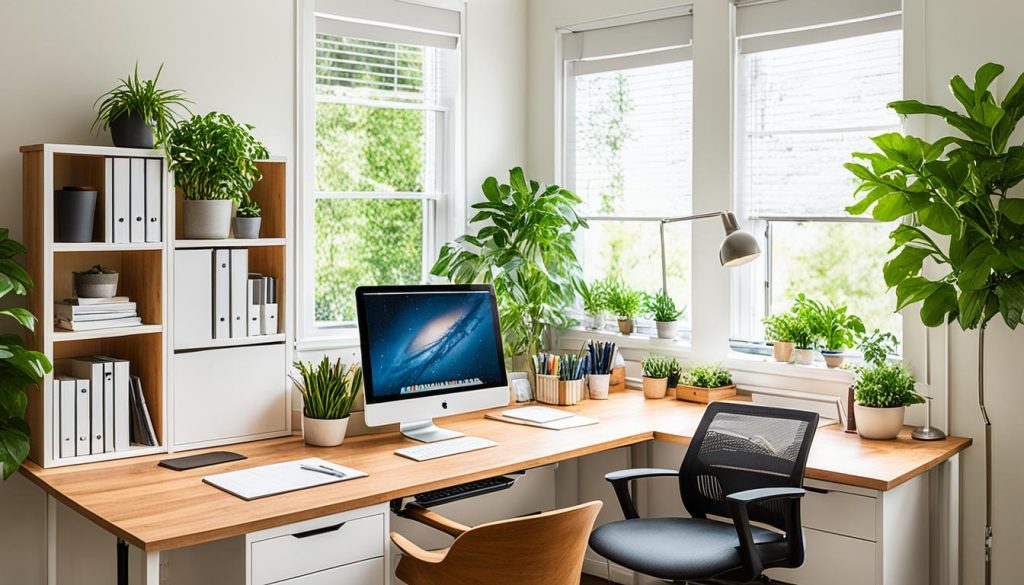
Choosing furniture for a shared office needs thought. Dual desks are great because they give each person their own space but look good together. Look for adjustable desks to fit different heights and what you like.
L-shaped desks are great for shared spaces because they give lots of room. They often have built-in drawers to keep things tidy. If your space is small, consider compact writing desks. They use space well without losing out on usefulness.
Ergonomic chairs are key for any shared office. Find ones that you can adjust to support you during long work hours. Being comfortable helps you work better!
- Choose adjustable standing desks for flexibility
- Opt for ergonomic chairs with proper support
- Consider compact desks for smaller spaces
- Select furniture that complements your home’s decor
When setting up your office for two, think about what each person needs and how it looks together. Choose furniture that shows off both of your styles but still looks good as a whole. With the right furniture, your shared office will be both useful and inspiring.
Home Office Design for Couples: Layout Ideas
Creating a home office for two can be tough. With more couples working from home, picking the right layout is key. Let’s look at some top dual desk setups to make your space work better for both of you.
Face-to-face setups
A face-to-face desk setup helps with teamwork and talking things over. It’s great for couples who often discuss work. Put two desks facing each other, with enough room to move around. Think about using standing desks for more flexibility and health perks.

Side-by-side arrangements
Side-by-side desks are ideal for couples who like similar work areas. This setup makes sharing tools easy. Pick a long desk or combine two desks for a single workspace. Make sure to have ergonomic chairs for comfort during long hours.
L-shaped configurations
L-shaped layouts give you both shared and private space in your office. This setup uses corner areas well and gives lots of desk space. You can adjust the desk lengths to meet your needs. An L-shaped setup is great for couples with different work styles or who want more personal space.
When designing your shared office, think about your room’s size and what you like. Try out different desk setups to find the best one that boosts productivity and harmony in your space.
Creating Distinct Work Zones
Setting up couples’ productivity zones is key for a peaceful shared home office. You can turn small areas into efficient work spots with smart ideas. Begin by setting clear work boundaries to keep focus and reduce distractions.

Use room dividers, bookshelves, or plants to separate your work areas. This method keeps a personal touch in the shared office. Make sure to have areas for different tasks, like a meeting spot or personal work areas.
Here are some tips for making clear work zones:
- Use paint or wallpaper to mark each area
- Place furniture to naturally separate spaces
- Add rugs to show off separate work areas
- Put up artwork to make each zone unique
Make sure your work areas are both useful and good-looking. Each zone should have outlets, storage for supplies, and room for needed gear. Well-defined work areas increase productivity and make your shared office more organized.
“A well-designed shared workspace can lead to more meaningful work and increased collaboration between partners.”
With careful planning and creative ideas, you can make a shared office that suits both partners’ needs and work habits. The main idea is to have clear boundaries while keeping a unified look.
Maximizing Storage in Shared Spaces
Setting up a home office for two means you need smart storage solutions. It’s important to balance personal and shared space. Let’s look at ways to keep your office tidy and useful for both people.
Shared vs. Individual Storage Solutions
Think about both shared and personal storage when designing your office. A 7×10 foot closet can become a shared spot for storage. Split the space so each person has their area. Use slim shelves that pull out for easy reach of supplies and papers.
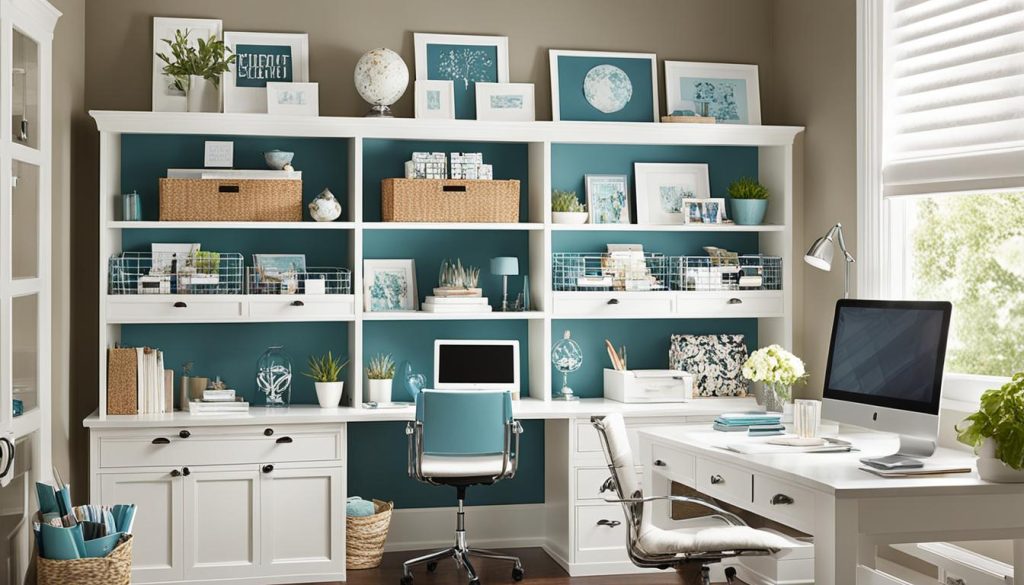
Creative Storage Ideas for Small Spaces
Vertical storage is great for small offices. Put shelves or bookcases on walls to use floor space well. Under-desk storage and rolling carts give you extra room for what you need. Open shelves are good for keeping things easy to get to while also showing off your decor.
- Use a central island for shared accessories and storage drawers
- Install custom shoe racks for office footwear
- Add tie and belt racks for a polished look
- Incorporate soft curtains to visually divide his and hers areas
Plan your storage for now and the future. A well-organized office helps both partners work better and live together more peacefully.
Lighting Solutions for Dual Workstations
Good lighting is crucial for a productive workspace for couples. The right lighting can improve your mood and work efficiency. Try to place your desks near windows for natural light. Use sheer curtains to reduce glare while keeping the area bright.
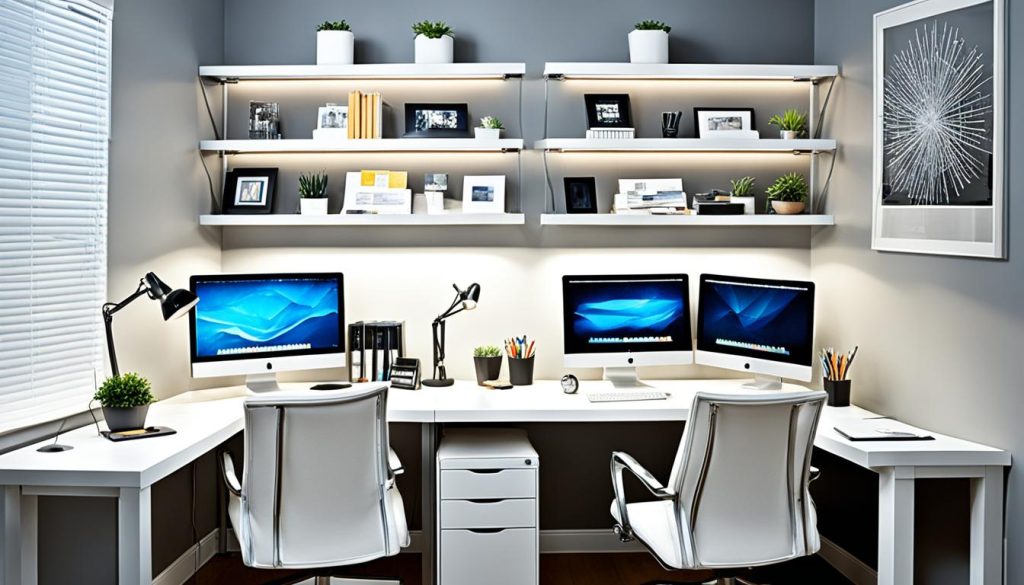
Task lighting is essential for each workstation. Adjustable lamps allow you to direct light exactly where you need it. This reduces eye strain and enhances your work performance. LED bulbs are a great choice because they last longer and use less energy.
Don’t overlook the importance of overall room lighting. Floor lamps or wall lights can create a welcoming atmosphere. They fill in shadows and make the space more comfortable. A combination of different light types works best:
- Ceiling lights for overall brightness
- Desk lamps for focused tasks
- Accent lights to add style
Good lighting does more than just help you see. It affects how you feel and work. In shared offices, each person may need different lighting. Flexible lighting options allow both of you to be comfortable and productive.
“Light is the first element of design; without it there is no color, form, or texture.” – Thomas E. Farin
With smart lighting choices, you can create a space where both of you can excel. Your home office will be bright, cozy, and ideal for working together.
Incorporating Personal Style in Shared Offices
Creating a joint office design that shows both partners’ tastes can be hard. The trick is to balance your personal likes with a unified look. Start by talking about your design styles and what you need for work.
Balancing Individual Tastes
Combine your styles by picking a common theme or color scheme. Choose furniture that you both like, like a big shared table instead of two small ones. This saves space for more storage and makes you feel closer.

Unifying Design Elements
Use smart ways to organize your shared space to keep it both useful and nice to look at. Put up shelving for storage and showing off personal items. Add pegboards for tidy office supplies. These ideas mix usefulness with style, making both of you happy.
Make your workspace look the same for a unified feel. Use the same desk chairs or similar lights on each side. For a personal feel, put custom nameplates on your desks.
“A well-designed shared office boosts productivity and fosters collaboration while respecting individual work styles.”
Your home office should show your personalities but also be professional. By mixing your tastes carefully, you’ll make a workspace you both adore.
Tech Setup for Two: Connectivity and Equipment
Setting up a dual workstation for your home office needs careful planning and the right tech. With 41% of Americans working from home, having a strong system is key. It must support both partners’ needs.
Begin with a fast internet connection. Go for at least 50 Mbps for smooth video calls and file sharing. Think about a mesh network for steady coverage at home.

For computers, pick reliable brands like Dell, Lenovo, or Acer for Windows users. If you’re into design, a MacBook Pro might be ideal. Adding a second monitor can also help, costing about $100.
- Ergonomic keyboards and wireless mice to prevent wrist strain
- Office chairs with lumbar support ($100-$150 range)
- Height-adjustable desks for health benefits
Put a shared printer and scanner in a spot everyone can reach. Use smart cable management to keep things neat. Cable sleeves and wire racks help organize cords and keep your space tidy.
Your home office should be both functional and comfy. Adding plants can lower stress and make work nicer. With the right tech and setup, you’ll have a productive space for both of you.
Soundproofing and Noise Management
In shared workspaces, keeping noise down is key for getting things done. A survey of 1,552 remote workers showed that 46.6% found family, roommates, or pets the biggest distractions. Cars (23.7%) and neighbors (21.5%) also caused a lot of noise trouble.
Acoustic Treatments for Shared Spaces
For these problems, think about using acoustic treatments in your shared office. Window inserts are a great choice, cutting down outside noise by up to 70% while letting in sunlight. They seal the gap between the acrylic panel and window frame, reducing noise from machines and outside sounds.

Noise-Cancelling Solutions
Invest in noise-cancelling headphones for focused work during calls or video chats. These are key for staying productive in shared areas. Make sure to set rules with your partner about noise and respect each other’s work space.
“Soundproofing for remote meetings is essential for productivity in home offices.”
By using these noise management tips, you’ll make your shared workspace quieter and more efficient. This helps everyone stay focused and work better together.
Flexible Seating Options for Comfort and Variety
Sharing a home office with your partner means making sure it’s comfy and versatile. Adding flexible seating can boost your productivity and happiness. Let’s look at ways to make your work areas more dynamic and inspiring.
Begin with ergonomic furniture for your main work areas. Choose chairs that adjust to support your posture and ease strain. Did you know, 75% of businesses now offer flexible workspaces to keep employees happy?
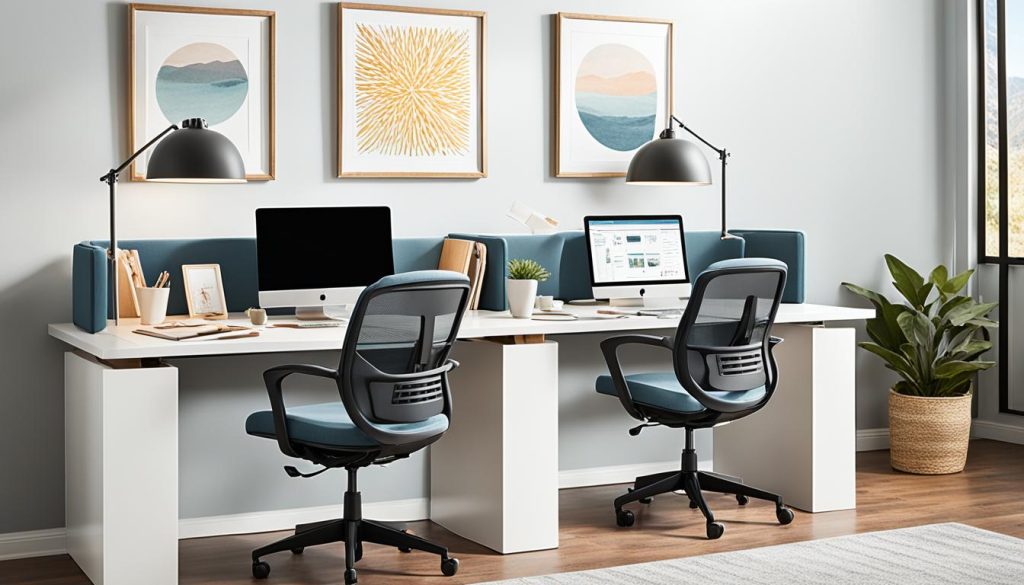
Break up the desk work with a small couch or loveseat. It’s perfect for brainstorming or casual chats. Adding an armchair for reading or calls keeps you away from your main desk.
For something different, consider these unique seats:
- Bean bag chairs for relaxed thinking
- Hanging chairs to add a playful touch
- Balance ball chairs to work out your core
Diverse seating can spark creativity and fight the health risks of sitting too much. Flexible offices often have open desks, standing desks, and lounge spots.
Your shared office should fit both of your needs. Talk about your work habits and likes. This way, your space stays comfy and effective for both of you.
Adding Greenery and Natural Elements
Adding plants to your home office can make it more productive and peaceful for couples. Plants help clean the air and make your space look better. This can make working together easier.

Begin by putting plants on your desks or setting up a vertical garden. Snake plants and spider plants are easy to care for and grow well in different lights. Adding terrariums or air plants can also bring a fun touch to your space.
Use natural materials like wood or stone to make your office feel cozier. A wooden desk or stone paperweights can add warmth. Try to place your work areas near windows for more natural light and views.
- Use found items like seashells, pinecones, or driftwood as unique decor pieces
- Create a rotating collection of natural elements to reflect the changing seasons
- Add a small indoor fountain for a soothing auditory element
Adding personal touches with nature can make your office feel welcoming and motivating. By choosing the right plants and natural items, you can create a space that helps both of you work better. This makes your shared office a place you both enjoy being in.
Color Psychology in Shared Workspaces
Color is key in designing a home office for couples. The right colors can make you more productive, improve your mood, and help separate work areas. Let’s see how color psychology can help make work zones for couples.
Choosing a Harmonious Color Palette
When picking colors for your shared office, think about how they affect both of you:
- Blue makes you calm and focused, boosting concentration by 10%
- Green makes you creative, helping you come up with 15% more ideas
- Yellow makes you happier, increasing creative thinking by 25%
- White makes the space feel bigger, cutting stress by 30%

Using Color to Define Spaces
In a shared office, color can mark different work areas:
- Use primary colors (red, blue, yellow) for areas meant for focused work
- Apply secondary colors (green, orange, purple) to spaces for teamwork
- Add tertiary colors to bigger shared areas
By using color psychology in your home office, you can make a space that boosts productivity, creativity, and happiness for both of you.
Maintaining Work-Life Balance in Shared Home Offices
Work from home couples often struggle to keep a good work-life balance. With 72% of Americans valuing work-life balance over other benefits, it’s important to set clear boundaries in your shared office. Having a daily routine with specific work hours and breaks can help increase productivity and stop work from taking over personal time.

To move from work to personal life, packing up your work stuff at day’s end is a good idea. This action marks the end of work and helps you mentally shift. Make sure to have specific areas for relaxing and fun, away from your work area.
Here are some tips to make working from home better:
- Upgrade old furniture that might be hurting your productivity
- Look into standing-height desks for better ergonomics
- Get comfortable chairs with options like mesh or fabric
- Consider desks or filing cabinets on wheels for more storage
Remember, clear boundaries are crucial for a good work-life balance for couples working from home. By using these tips, you can make a shared office space that supports both work and well-being.
Closing Thoughts
Creating a cozy home office for couples is a fun journey. It mixes functionality with style. You’ve seen many ideas, from sleek to vibrant spaces. With 65 ideas, you’re ready to make a space that fits both of you.
Your shared office should show your unique tastes and work styles. It doesn’t matter if you have a small or big space. The goal is to make areas that meet each person’s needs. We’ve seen how location and architecture can shape design choices.
When redoing your home office, think about adding space-saving furniture and colors you love. Adding sports-themed artwork can also make it personal. Remember, mix looks with comfort. A fancy desk and a comfy chair make work better.
Plan your shared workspace well. This way, you’ll have a place that helps you work better and brings you closer as a couple.

